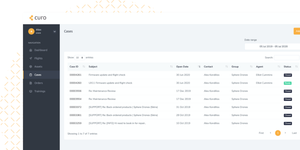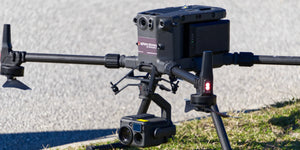Sphere Drones has witnessed the evolution of drone technology first hand since 2012 and the advancements it has brought across various industries, with drone surveying being at the top of the list.
In this article, we break down the basics of drone surveying, key workflows like photogrammetry and LiDAR, and show how drones boost efficiency and accuracy.
What is drone surveying?
Drone surveying uses drones equipped with high-res cameras and sensors—like RGB, multispectral, thermal, and LiDAR—to capture aerial images and data of landscapes, assets, and structures.
Surveyors often use ground control points (GCPs) to geo-reference the captured data. While not always necessary, GCPs help validate data accuracy.
Why use drones in surveying?
- Efficiency: Drones cover large areas quickly, slashing project timelines compared to traditional methods.
- Cost-effectiveness: With less manual labour and time on-site, drones can save you a lot of money, especially on big projects in remote areas.
- Safety: Drones can reach hard-to-access or dangerous areas without risking the safety of surveyors.
- Accuracy: Advanced sensors and GPS tech make drones highly accurate, improving the reliability of your survey results.
Our top pick for photogrammetry is the Zenmuse P1 from DJI, with its 45MP full-frame sensor and impressive accuracy, even without GCPs.
Key workflows: Photogrammetry and LiDAR

Photogrammetry
Photogrammetry is a process that involves capturing multiple overlapping images from different angles and using software to create 2D maps and 3D models of the surveyed area. This method is ideal for generating high-resolution orthomosaic maps, topographic maps, and 3D models, which are valuable for various applications such as construction, agriculture, and land development.
Workflow
- Image capture: Drones capture a series of overlapping images of the target area.
- Image processing: Specialised software stitches these images together to create detailed maps and models.
- Analysis: The resulting data can be analysed for various purposes, such as measuring distances, areas, and volumes.
Photogrammetry case study
Our team worked with the K92 mining operations team in Papua New Guinea to implement drone technology into its operations to improve their efficiency and productivity. This included a photogrammetry solution.

LiDAR
LiDAR technology uses laser pulses to measure distances between the drone and the ground, generating precise 3D models of the terrain and structures. This method is particularly useful in areas with dense vegetation or complex topography where traditional photogrammetry may struggle to penetrate.
Workflow
- Data collection: Drones emit laser pulses that reflect off surfaces and return to the sensor, calculating distance based on the time taken for the light to return.
- Data processing: Software processes the collected data to create detailed 3D point clouds and models.
- Applications: LiDAR is widely used in forestry, environmental monitoring, archaeology, and infrastructure development.
LiDAR case study
Our team have worked with many clients on their LiDAR data capture setups, including Evoegy Consulting, who has been using a DJI Matrice 350 + Zenmuse L1 to capture data for energy asset lifecycle management.
Drone surveying represents a significant leap forward in data collection technology, offering numerous advantages over traditional methods. With workflows like photogrammetry and LiDAR, drones provide efficient, cost-effective, and highly accurate data, making them an indispensable tool across various industries.
If you are interested in exploring the use of drones for surveying, photogrammetry or LiDAR within your business. Get in touch with our team using the form below, or give us a call on 1800 119 111.





















